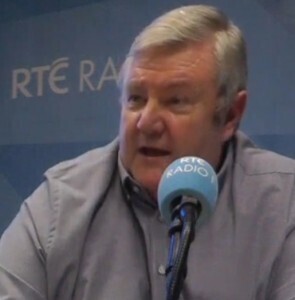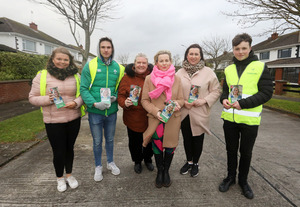Top: Fianna Fáil members canvassing in Derry, from left: Mark Holt, Frank Kennedy, Briege MacOscar, Jim O’Callaghan TD, Colum Eastwood SDLP leader, Richard Comerford, Kathleen Hunt, Derek Mooney; Derek Mooney
Hot on the heels of my by-election punditry… well, three out of four is not bad… let me throw my not too jaundiced eye over the race for the 18 House of Commons seats in Northern Ireland. There went 10 DUP, 7 Sinn Féin and 1 Ind Unionist last time, in 2017.
Unlike the four by-elections here, which were run under PR (proportional representation) the seats in Northern Ireland seats will be allocated under the arcane and unfair first-past-the-post (FPTP) system.
Not that this system always disadvantages nationalists.
In 2015, then SDLP leader, Alasdair McDonnell held his South Belfast seat with 24.5% of the vote, just 900 votes (2.3%) ahead of the DUP candidate. This accomplishment left McDonnell with the dubious honour of being the MP with the smallest ever vote share.
Though he increased it at the 2017 election, McDonnell failed to hold on, losing out to the DUP who saw their vote jump by a whopping 8%. It is a feat they are unlikely to repeat this time around, but I will return to Belfast South in more detail later.
First let’s take a quick look at the 10 constituencies where there is no question about how they’ll end up, as the winning party in each case had majorities ranging from just under 8,000 votes to over 21,500. They are:
DUP:
- North Antrim – 20,643 majority
- Lagan Valley – 19,229 majority
- Strangford – 18,343 majority
- East Antrim – 15,923 majority
- East Londonderry – 8,842 majority
- Upper Bann – 7,992 majority
Sinn Féin:
- Belfast West – 21,652 majority
- Mid Ulster – 12,890 majority
- Newry and Armagh – 12,489 majority
- West Tyrone – 7,956 majority
This is not to suggest that the remaining eight seats are all up for grabs. They are not. Two, or maybe three, look like changing. It is just that the winning margins the last time put these in the ones to watch pile.
So here, in reverse order, are my assessments of the remaining eight NI seats. First, let’s look at five seats where there could be some political shifts, though not enough to change the outcome.
South Antrim. The DUP took this seat from the UUP in 2017 by about 3200 votes. Though it is unlikely to swing back, the former UUP’s candidate, the ex-MP Danny Kinahan is well regarded. If the UUP is to have a future, then it really needs to start winning back support in seats like this. A DUP hold
South Down. For almost three decades this was solidly SDLP, but a big swing to SF’s Chris Hazzard saw him topple Margaret Ritchie, one of three former SDLP leaders to lose their seats in 2017. Hazzard’s majority is just under 2.500 and the SDLP’s candidate Michael Savage is running one of the strongest ground campaigns seen in the area since the days of the legendary SDLP MP Eddie McGrady. Probably a Sinn Féin hold, but it’s vulnerable.
North Down. Held for almost 18 years by independent unionist, Lady Sylvia Hermon, previously UUP, the strongly anti-Brexit MP is not standing again. The DUP vote in this affluent and solidly Unionist constituency jumped by 14% between 2015 and 2017 when its candidate Alex Easton finished up just 1208 votes behind Hermon.
Hermon announced her intention not to seek re-election after the SDLP, SF and the Greens had decided not to challenge her. While Alliance should be the beneficiary of their unintended largesse, its wilful refusal to strategically stand aside elsewhere to help remain candidates suggest it won’t.
Logic says that the DUP should win (it took 3 of the 6 Assembly seats here last time), though instinct says that voters in a seat that went 53% remain in 2016 will not be content to see a pro-Brexiteer replacing an anti-brexiteer. Oh, the joys of FPTP! Barring some seismic Alliance surge, this looks like a DUP gain.
East Belfast. In truth, this constituency should be in the list of 10 safe seats as the sitting DUP MP’s 2017 winning margin of 8,474 votes (a vote share of almost 56%) hardly puts it in the ones to watch column.
East Belfast is unionist heartland. It was represented by the former DUP leader Peter Robinson for 30 years, but it was his famous 2010 defeat by Alliance’s Naomi Long that puts East Belfast on this list.
The current MP Gavin Robinson (no relation) is seen as a moderate, in DUP terms. It is hard to see Long pulling off another 2010 win – notwithstanding her big success at the European Election. Long’s best chance of securing an Alliance seat may have been to move herself to the neighbouring North Down. This is a DUP hold.
Fermanagh and South Tyrone. One of the three seats on this list where the contest is between unionism and nationalism (see also Belfast North and South). Sinn Féin’s Michelle Gildernew took the seat back from the UUP’s Tom Elliott by 875 votes in 2017. While this would be regarded as a slim majority elsewhere, in the history of Gildernew wins here since 2001 it ranks among one of the biggest.
While the DUP have again withdrawn to facilitate Elliott, and Sinn Féin is seeing some discontent among its own voters, it is difficult to see the hard-working and well liked Gildernew losing out this time. A Sinn Féin hold.
This brings us to the three critical seats:
North Belfast. The race here is between the DUP and Sinn Féin – no surrogates or proxies. It is a winner takes all contest under a winner takes all voting system. One of just two constituencies where there are only three candidates (East Belfast being the other).
The sitting MP, the DUP’s Nigel Dodds held on by just under 2100 votes in 2017. Sinn Féin’s John Finucane is hoping that a strong anti-Brexit message and the absence of SDLP and Green party candidates and will see their 2700 votes come his way. Taking the seat off arch brexiteer Dodds would be a huge win.
But, Dodds has been here before. Back in 2010 he saw his majority fall to 2200, only to almost triple it five years later. Also, the presence of an Alliance candidate risks siphoning off remain voters unwilling to commit to Finucane. While the odds favour Dodds on paper, a nasty postering and banner campaigns by loyalists in both North and South Belfast may backfire.
While last week’s not quite full Ulster Hall rally, with its strident pro-Brexit and unionist imagery, was intended to unite and invigorate unionism, it was also a signal to moderate nationalists and others that one way to rid Northern Ireland of that political extreme is to defeat Dodds. While I think Dodds will win, every election produces a surprise, and this could be it.
This brings us to the two seats which I expect to switch hands.
Foyle: The Derry city constituency of Foyle was once the seat of John Hume and later Mark Durkan. Durkan’s 2017 defeat by Sinn Féin came as a body blow, the tightness of the margin, 167 votes, making it feel even worse.
Winning this seat back is a key goal for the SDLP’s new leader, Colum Eastwood and all the signs are that he is set to do it. [I should declare an interest here: I know Colum well and have been a supporter of his for years, including canvassing for him last week in Derry.]
Where winning the seat back is important to the SDLP and its Fianna Fáil partner, not losing it is an absolute imperative for Sinn Féin. It has poured a lot of manpower and resources, over the past few weeks, into trying to cling on, but just a few hours knocking on doors in what should be strong SF areas tells you that it is too late. SDLP gain at SF expense.
South Belfast. The contest here is between sitting DUP MP Emma Little-Pengelly and the SDLP’s Claire Hanna. This staunchly pro-remain constituency (70%:30%) is set to return one of the most articulate, vibrant and dynamic pro-remain voices on the Northern Ireland political scene, Claire Hanna.
The decision by both the Green and Sinn Féin parties to stand aside in Hanna’s favour all but makes her election inevitable, so you have to again wonder at the Alliance strategy to stay in a race where it can, at best, only be a spoiler who helps the pro leave DUP. SDLP gain from DUP
So, there you have it. Based on the assessments above I expect the final totals should look either like this:
- 10 DUP – Unchanged. Loses 1 in S Belfast and gains 1 in N Down
- 6 SF – Down one. Loses Foyle
- 2 SDLP – Up 2, Foyle and S Belfast.
Or, this
- 9 DUP – Loses 1 each in S Belfast and N Belfast, gains 1 in N Down
- 7 SF – Unchanged. Loses Foyle but gains N Belfast.
- 2 SDLP – Up 2, Foyle and S Belfast.
The significance of this second scenario is that it would mark parity between nationalist and unionist Westminster representation – 9 seats each.
Derek Mooney is a communications and public affairs consultant. He previously served as a Ministerial Adviser to the Fianna Fáil-led government 2004 – 2010. His column appears here every Monday.Follow Derek on Twitter: @dsmooney








Is there going to be tactical voting along Brexit lines Derek? NI was always solid remain but I would expect more so these days- will some pro remain unionists ‘hold their nose’ I wonder?
Lets not forget that Claire Hanna was a vocal opponent of the SDLP/FF ‘engagement’ of course. Could you have a word with Eastwood and tell him to dye that friggen white but on the beard? Distracting is not the word for it.
Was about to ask same re tactical voting (not the beard thing). An interesting analysis here but this is no ordinary election. Not that 2017 was ordinary and party-linear either but this one is all about Johnson’s majority and his/the EU’s Deal.
I would like to see the SDLP get those two extra seats, esp the Foyle one.
‘…three out of four is not bad’…let me guess which one you got wrong…
Sinn Fein may drop a seat. DUP may drop a seat. It doesn’t matter in relation to the dominating weight of Little England nationalism among Labour and Conservative voters. Northern Ireland will carry minimal clout when the Leave forces make the final heave.
thanks for this Derek
So are FF out canvassing for the local FF Derry candidate ?
Oh, there isn’t one.
So what are politicians from one jurisdiction doing in another jurisdiction canvassing? Why aren’t they canvassing therefore in London?